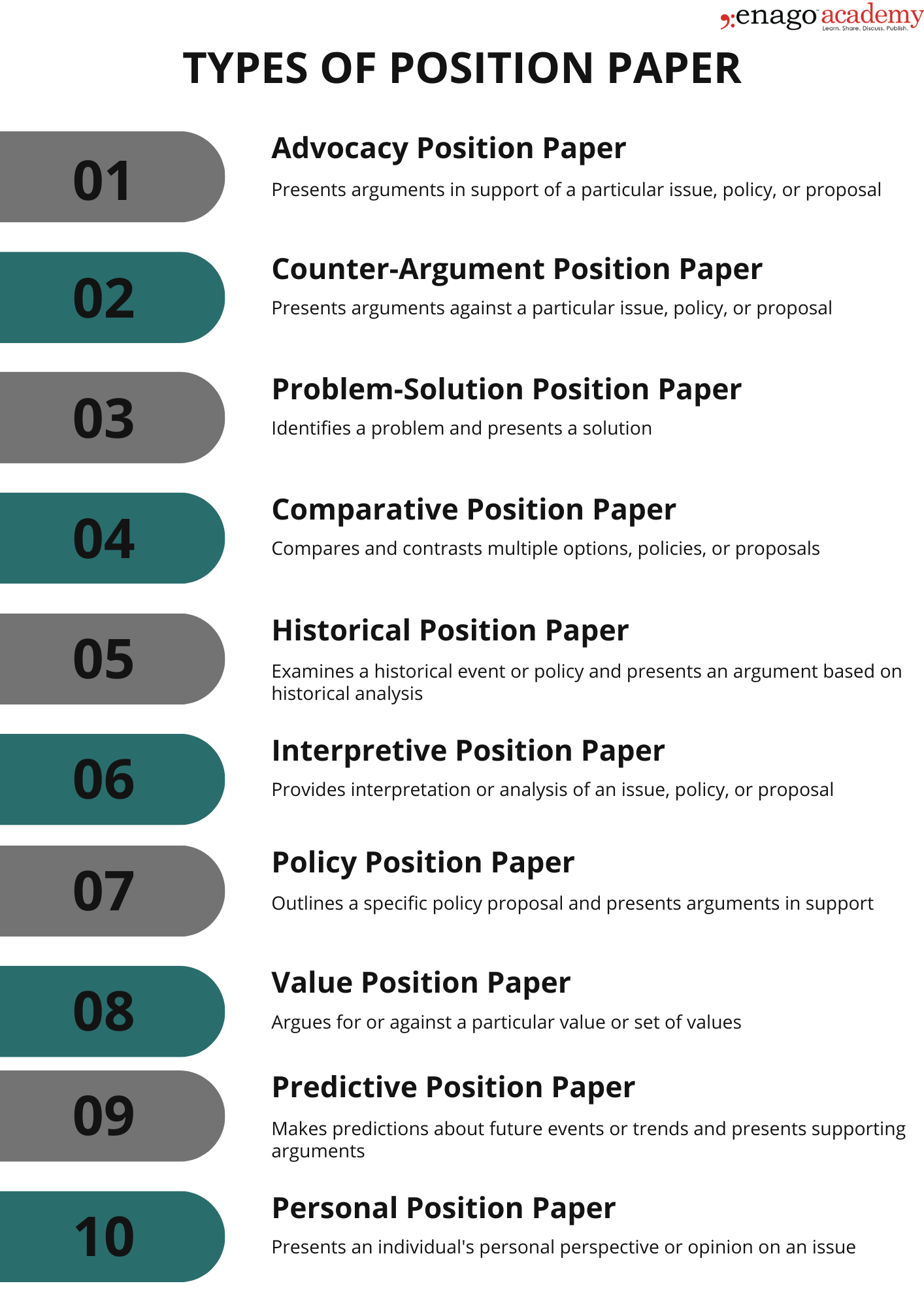Top 10 Tips for Writing a Strong Position Paper

As scientists and researchers, you might be familiar with objective research papers, which tend to consider both sides of an argument and present findings based on facts. But are you aware of another important piece of academic writing known as the position paper? In this article, we will discuss different aspects that make position paper share expert tips on writing a great position paper that clearly presents an argument or opinion.
What Is a Position Paper?
A position paper discusses a controversial issue and focuses on one aspect of an argument, providing valuable insights on how to interpret issues where science is ambiguous. It can also act as a medium for scientists and researchers to put forth solutions to resolve problems. Similar to objective research papers, position papers are still rooted in facts, statistics, evidence, and data. Additionally, they further enable authors to take a position on what these facts and data are telling us.
The purpose of a position paper is to gather support for an opinion on an issue by explaining the author’s stance and providing factual evidence to back it up. It critically evaluates the position, acknowledging its strengths and weaknesses.
Types of Position Paper
There are several types of position papers, each serving a unique purpose.
How to Write a Position Paper?
1. Choosing a Good Topic
Selecting a good topic for your position paper is just as important as having a well-structured paper that presents a strong argument. A well-written paper about an uninteresting or uncontroversial topic is simply a waste of time and effort. So how can you best choose a topic for your argument?
Like all types of research, you should begin with preliminary research. A good topic for a position paper will answer yes to the following questions:
- Does the topic represent a genuine controversy?
- Are there two clear positions?
- Do you care enough to argue for one of those positions?
- Is the scope of the topic manageable?
Once you have found a topic that meets these criteria, you will need to conduct research to build a solid case in favor of your argument. This means finding supporting evidence (for both sides!) just as you would for an ordinary research paper. By including supporting evidence for the opposing side, you will be able to more clearly refute the conflicting arguments. In other words, you can point out weaknesses in the evidence cited by the opposing side or highlight strengths of evidence that supports your stand in comparison.
2. Conducting a Preliminary Research
Conducting preliminary research is crucial before delving into any topic. Evaluate evidence quality from reputable sources institutional websites, white papers, policies, scholarly articles, research reports, etc. Stay objective, dedicating some time for research. Be adaptable; reconsider your topic if evidence is lacking or contradictory. Prioritize quality over quantity in source selection. This ensures a well-supported and credible argument.
3. Crafting and Testing Your Thesis Statement
Crafting a thesis statement is a pivotal step in developing a coherent paper. This statement depicts your stance on the topic. A clear and focused thesis statement serves as the backbone of your argument, guiding the reader and shaping the trajectory of your analysis. Once established, subject it to rigorous examination by challenging it.
While it may seem counterintuitive, actively challenging your own thesis statement is a vital exercise in academic integrity and intellectual rigor. By earnestly considering opposing viewpoints and potential counterarguments, you not only demonstrate a comprehensive understanding of the subject matter but also fortify your position through logical reasoning and evidence-based support.
4. Collecting Supporting Evidence
When gathering evidence for your position paper, prioritize relevance and credibility. Use expert quotes sparingly, ensuring they directly support your argument. Prefer research-based evidence over anecdotes, focusing on quality rather than quantity. Verify the credibility of sources and regularly update evidence to reflect the latest research. Following these guidelines enhances the credibility and persuasiveness of your paper.
5. Drafting and Structuring the Position paper
The structure of a position paper is flexible, but it should generally follow a simple flow that clearly conveys the problem and the position of the author(s). A position paper should begin by clearly stating the problem and its relevance to the scientific community or even to the society as a whole. It should then address the main position of the author. For example:
a. Background: For decades, the WHO has urged the adoption of a tax on unhealthy foods to discourage the consumption of products that are harmful to our health.
b. Relevance: Sugar has been shown to have a negative impact on health, and play a major role in the rising obesity rates in America.
c. Position: The United States should adopt a tax on drinks with added sugar, to reduce the consumption of sugar, and promote healthier eating habits.
The author should then clearly list the common arguments and possible objections against this position. To continue with our example:
Argument 1: A sugary drink tax that focuses on soda may not impact other products that have an equally negative health impact such as fruit juice or candy.
Argument 2: A sugary drink tax is regressive and places a financial burden on the poorest consumers.
A strong position paper acknowledges the validity of the counter-arguments and then puts forth reasons why the author’s position is still the correct one. In our example paper, the author can address the counter-arguments in the next section like so:
Counter-argument 1: It is true that a sugary drink tax would not impact all sources of added sugar in the average American diet. However, it would still have a significant impact on a major source of added sugar to achieve its goal of reducing overall sugar consumption.
Counter-argument 2: All consumption taxes are regressive. A sugary drink tax would be most effective accompanied by subsidies for healthy foods such as fruit and vegetables.
Finally, summarize your main points and re-state your position in your conclusion. All arguments in the paper should be backed up by facts, data, and evidence, with proper citation attributed to your sources. In this way, a position paper is no different from an ordinary research paper. If you wish, you can include a brief literature review in your discussion of the background of the issue. While such a literature review is not essential, it can make your paper stronger.
Ten Tips for Writing a Strong Position Paper
Now that we know what a position paper is, let us review some tips to write a great position paper.
- Select a timely, relevant topic with two clear opposing sides.
- Conduct thorough preliminary research, collecting evidence supporting arguments for and against your position.
- Identify your intended audience. You should tailor your tone depending on who the paper is written for (the public, other scientists, policymakers, etc.).
- Clearly state your position on the topic.
- List and refute the counter-arguments to your position.
- Include supporting data and evidence to back up your argument.
- Properly attribute your sources using correct citation.
- Keep it simple! Position papers don’t need to go into excessive detail. Present your points clearly and briefly.
- Each paragraph in the paper should discuss a single idea.
- Have someone proofread your paper to ensure it reads well and looks professional.
A position paper can be a great way to expand your horizons and write a new type of research paper. Use these ten tips to write an effective position paper!
Are you seeking advice on writing a position paper? Seek professional assistance to craft a compelling argument in your position paper that effectively communicates your perspective to the scientific community.
Frequently Asked Questions
The length of a position paper can vary depending on the requirements set by the institution or conference. However, typically, position papers are concise and focused documents, usually ranging from 1,000 to 2,000 words.
The purpose of a position paper is to articulate an author's stance on a particular issue or topic, backed by factual evidence and logical reasoning.
Characteristics of a position paper include: 1.Focus on a controversial issue or topic. 2.Clear statement of author's stance or position. 3.Incorporation of factual evidence, statistics, and data. 4.Acknowledgment of counterarguments and addressing them effectively. 5.Concise and well-structured presentation of arguments.












Very informative
This is an academically certified approach to writing a position paper. I love it! Bravo!